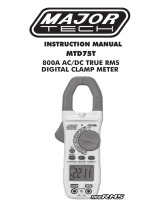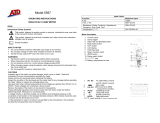
EX845-EU-EN v2.6 11/13
9
Data Hold
To freeze the LCD reading, press the HOLD button. While data hold is active, the HOLD icon
appears on the LCD. Press the HOLD button again to return to normal operation.
Peak Hold
The Peak Hold function captures the peak AC or DC voltage or current. The meter can capture
negative or positive peaks as fast as 1 millisecond in duration.
1. Turn the function switch to the A or V position.
2. Use the MODE button to select AC or DC
3. Allow time for the display to stabilize.
4. Press and Hold the PEAK button until “CAL” appears in the display. This procedure will zero
the range selected.
5. Press the PEAK button, Pmax will display.
6. The display will update each time a higher positive peak occurs.
7. Press the PEAK button again, Pmin will display. The display will now update and indicate the
lowest negative peak.
8. To return to normal operation, press and hold the PEAK button until the Pmin or Pmax
indicator switches off.
Note: If the Function switch position is changed after a calibration the Peak Hold calibration must
be repeated for the new function selected.
MAX/MIN
1. Press the MAX/MIN key to activate the MAX/MIN recording mode. The display icon "MAX" will
appear. The meter will display and hold the maximum reading and will update only when a new
“max” occurs.
2. Press the MAX/MIN key and “MIN” will appear The display icon "MIN" will appear. The meter
will display and hold the minimum reading and will update only when a new “min” occurs
3. Press the MAX/MIN key and a blinking “MAX MIN” will appear. The meter will display the
present reading, but will continue to update and store the max and min readings.
4. To exit MAX/MIN mode press and hold the MAX/MIN key for 2 seconds.
Temperature Units (˚F / ˚C)
The temperature units selection switch is located in the battery
compartment. To change the units, remove the battery door, lift out the
battery and set the switch for the desired units.
LCD Backlight Button
The LCD is equipped with backlighting for easier viewing, especially in
dimly lit areas. Press the backlight button to turn the backlight on. Press
again to turn the backlight off.
Automatic Power OFF
In order to conserve battery life, the meter will automatically turn off after approximately 10 minutes.
To turn the meter on again, turn the function switch to the OFF position and then to the desired
function position.
Units Switch
F
C















